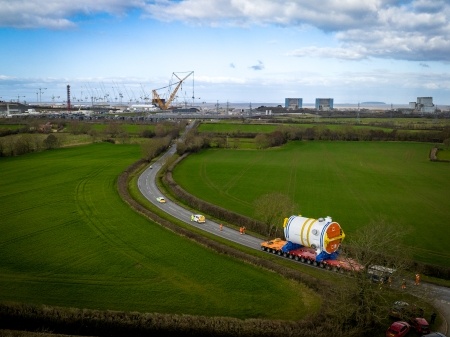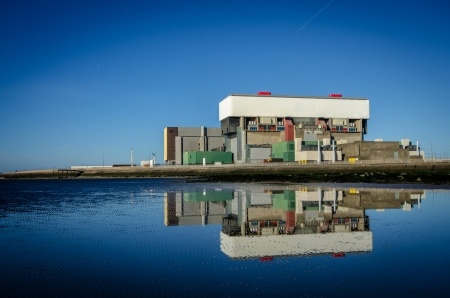
R&D team awarded funding for long duration energy storage project
Long Duration Energy Storage (LDES) systems will play a fundamental role in decarbonising Great Britain's energy system, as they provide flexible and reliable capacity while enabling higher utilisation levels of renewable energies. Historically, LDES systems have been mainly associated with pumped-hydro schemes. However, more recently, advancements in technologies - such as Compressed Air Energy Storage (CAES) - have led to a proliferation of interest from investors and proofs-of-concept in these technologies. The fundamental principle behind CAES is the gas turbine cycle, where surplus power is employed to compress air, which is subsequently stored in an underground chamber using a compressor. When energy is required, the stored compressed air is released from the chamber and directed through an air turbine, generating electricity through the flow of highpressure air. UK possesses a very good potential for CAES, enough to greatly exceed necessary energy storage, owing to the abundance of salt caverns.
In this context, in 2022, a consortium of EDF, iO Consulting, and Hydrostor won £1 million from the United Kingdom (UK) government Department for Energy Security and Net Zero (DESNZ) competition to develop storage of electricity as compressed air, potentially using mothballed EDF owned gas cavities in Cheshire (UK). This project, called StrataStore, is designed to help address the problem of intermittent renewable energy sources such as wind and solar power, which are dependent on weather conditions. The facility will be able to store excess energy generated by these sources during times of low demand, and then release it during periods of high demand. This will help to balance the supply and demand of energy on the grid and reduce the need for fossil fuelbased power generation. As a project partner, EDF performed a business analysis considering different CAES system configurations to evaluate the impact of the system parameters on the total project revenues. Precisely, 4 different scenarios were considered as illustrated next.
To define the model framework, we also establish a set of key assumptions that represent the foundation for our analysis and serve as the basis for determining the potential impact of market and technical parameters on the performance of CAES system designs:
1. The markets examined are: wholesale market (Day-ahead (DA) market), Capacity Market (CM) and, short term operating reserve (STOR).
2. For STOR, availability is assumed at 50% between 9-11pm (need to sustain for at least 2 hours and a maximum 4 hours) each day all year.
3. Lifetime of the CAES unit is assumed as 25 years, and no degradation nor selfdischarge are considered. CAES starts half-empty at the beginning of the simulation.
The insights of StrataStore provide an evidencebased analysis of the key market barriers and policy challenges faced by LDES investors in the UK. Likewise, this study, and associated results, can support and inform various LDES stakeholders and policymakers regarding the economic viability of these systems, as well as in designing suitable remunerative mechanisms to facilitate the deployment of CAES in the UK. The main outcomes of the StrataStore project Phase 1 are:
1. The DA market energy prices will decrease with time as the percentage of renewable energies rises leading to the closure of many fossil fuels generation units. This will also lead to increased volatility in energy Monthly Newsletter EDF UK R&D EDF R&D UK Centre Limited. Registered in England and Wales. Registered No. 02948613. Registered Office: 90 Whitfield Street, London, England, W1T 4EZ Page 6 of 8 PROTECT-PROPRIETARY prices, providing opportunities for utilizing storage facilities to seek energy arbitrage.
2. The CM de-rating factor is a key parameter that considerably affects the CM revenue streams. National grid considers LDES assets that operate more than 9h, giving them a de-rating factor of 95%. All the facilities that operate for less than 9h will lose a minimum of 20%. Therefore, designing an energy storage asset that operates for 9 hours or more is crucial for maximizing revenue.
3. Additionally, revenue streams for energy storage technologies are affected by the type of service provided, with faster response times generating higher revenues. In the case of CAES, Short Term Operating Reserve does not stand as an essential source of revenue as, in all configurations, they represent less than 20% of the total project profit.
In this context, preliminary findings show that current GB market structures are unlikely to capture the full value of LDES projects to the energy system. These results were presented and disseminated to an audience of relevant industrial stakeholders as well as regulatory and policy makers, on the 13 th of December 2022.
Moreover, the UK R&D team has been engaging not only with key industry leaders at DESNZ and Energy Systems Catapult, but also with other EDF Group business units in North America and Chile, EDF Pulse Ventures, as well as other EDF R&D Centres (e.g. France, USA and Singapore), as LDES takes a central role in EDF Group decarbonisation strategies. To that aim, the StrataStore project will continue in 2023 to investigate key market mechanisms to promote CAES in the UK, such as implementing Cap and Floor procedures and/or introducing reforms in the GB Capacity Market.
Copyright image - StrataStore
Related articles

EDF UK R&D Net Zero Heroes: Ruth

Exciting progress on hydrogen plans for Heysham 2
